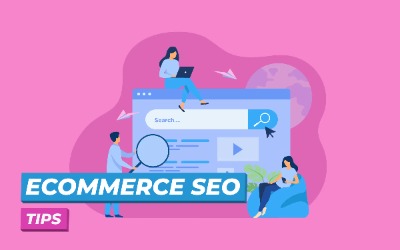Getting more visitors to your ecommerce store is crucial for growing your business. One of the best ways to drive consistent traffic is through search engine optimization (SEO).
SEO is the process of optimizing your website and content to rank higher in search engines like Google. The higher your pages rank for relevant searches, the more organic traffic you will receive. This traffic converts at a much higher rate compared to paid ads or social media.
With effective SEO, you can reach new customers who are already searching for your products or services. As you improve your rankings, your ecommerce store will start receiving a steady stream of qualified visitors each month. This ultimately leads to more sales and revenue.
In this article, we'll cover some of the top ecommerce SEO tips to help you get found by more customers.
7 Ecommerce SEO Tips For Increasing Organic Traffic
1. Optimize product pages with keywords
Your product pages are really important areas to optimize with relevant keywords. This helps make sure your products can be found by people searching for those terms.
Do keyword research to identify high-traffic keywords that relate to each product. Google's free Keyword Planner is a good starting point. Paid tools like Keywords Everywhere provide more in-depth data.
Include your most important keywords in the page title and meta description for each product. But don't just spam keywords everywhere. Instead, use them in a natural way that sounds good to users.
When naming product images, include the target keywords. Write descriptive ALT text for each image that includes keywords as well.
Optimizing individual product pages makes it possible for each one to rank for their core terms. This gets your products found more easily by ideal customers.
2. Create an internal linking structure
Having a good internal linking structure reinforces to search engines what pages are most important on your site.
Link related products and categories together within content. This helps search bots better crawl and index your site.
Use descriptive anchor text for internal links. For example say "shop women's dresses" instead of just clicking "here". Anchor text is the visible, clickable text in a link.
The more you link to a certain product or category page internally, the more authority you pass to that page. So be strategic with internal links pointing to key pages like product URLs and your home page.
Make sure to check for any broken links on your site occasionally. These are links that go to 404 error pages rather than working pages. Fix or remove broken links when found.
An effective internal link structure makes a site more user-friendly while signaling to search engines the relative importance of ecommerce pages.
3. Optimize your images
Images can help boost your ecommerce SEO when properly optimized.
Compress any large image files to improve site loading speed. There are free online tools to easily compress images.
When possible, use JPEG or next-gen WEBP image formats. Both are optimized for faster loading.
Fill out the ALT text field for each image with target keywords and descriptive captions. Search engines read ALT text.
Add schema.org markup to product images to enable rich result previews in Google Images. Structured data attracts clicks.
Following image SEO best practices enhances the chance of your product images appearing in search results. Optimized images also improve site speed and conversion rates.
4. Improve the overall structure of your website
Optimizing your site's overall structure and semantics helps search engines better understand your pages.
Make sure your product and category pages have descriptive, keyword-rich URLs. For example "blue-dresses" rather than just numbers.
Pages should be semantically structured with proper HTML headings and markup. You can use tools like the Detailed SEO browser extension to check page structure.
Improve your website navigation and menus so visitors can easily find what they need. Logical site architecture benefits both users and search bots.
Having a clean website structure with semantic HTML and user-friendly navigation provides clues to search engines about your important ecommerce content.
5. Focus on building backlinks
Backlinks from external websites are like votes of confidence that boost your authority in search engines' eyes.
Create high-quality content like online tools, guides, or resources that sites may naturally want to link to. Useful assets that add value have good link potential, such as our Business Idea Generator.
Reach out to influencers and brands to see if they would be interested in linking to your content in exchange for a link back. Look for mutually beneficial opportunities.
Participate in blogger outreach by providing useful guest posts to earn backlinks from relevant sites. Avoid spammy link networks.
Get your ecommerce site listed in relevant directories and review sites to build niche-specific backlinks. Each new link helps improve rankings.
Link building takes time and effort but earns long-term SEO gains. The more quality sites linking back to you, the higher your organic search visibility.
6. Increase page loading speed
Page speed is a ranking factor, so optimizing loading times should be a priority. Slow sites lead to high bounce rates.
Optimize and compress all images to reduce file sizes. Enable caching in your CMS and CDN to allow faster page loads.
Minimize HTTP requests by combining files and using asynchronous loading. Enable gzip compression to reduce file transfer sizes.
Clean up bloated code to reduce overall page weight. Eliminate unnecessary plugins that slow things down.
If needed, upgrade to faster web hosting with more resources. Quick loading speeds enhance user experience and search rankings.
With a fast, optimized site, visitors will stick around longer, boosting engagement metrics. Speed should be regularly monitored and improved.
7. Optimize your pages for Google E-A-T
Google wants to surface high-quality sites that offer expertise, authoritativeness, and trustworthiness - or E-A-T. Optimizing for these factors can improve rankings.
E-A-T stands for Expertise, Authoritativeness, and Trustworthiness. Pages that demonstrate these qualities tend to perform better in search results.
Clearly display business info and contact details to convey authority and transparency. This builds user trust.
Create detailed, high-quality content written by subject matter experts. Well-researched content demonstrates expertise.
Encourage genuine customer reviews. User-generated content adds trust signals. Moderated reviews may also be shown on listings.
Optimizing your ecommerce site for E-A-T provides assurance to Google that your brand is reputable and meets quality guidelines.
Conclusion
Implementing ecommerce SEO best practices takes time and dedication. But the long-term payoff is well worth the investment.
By optimizing your technical site elements for speed and performance, you provide a better user experience. Pair this with targeted content optimization, and your pages become more findable by search engines and shoppers.
Related: How to Start a Dropshipping Business in 2023
An effective SEO strategy requires staying on top of the latest best practices and trends. SEO is an ongoing process, not a one-time fix.
If you need additional help improving your ecommerce SEO, consider consulting with a knowledgeable SEO expert. Their technical knowledge and optimization guidance can take your organic search visibility to the next level.
With a sound SEO foundation and consistent optimization efforts, your ecommerce store can consistently attract more high-intent traffic.

